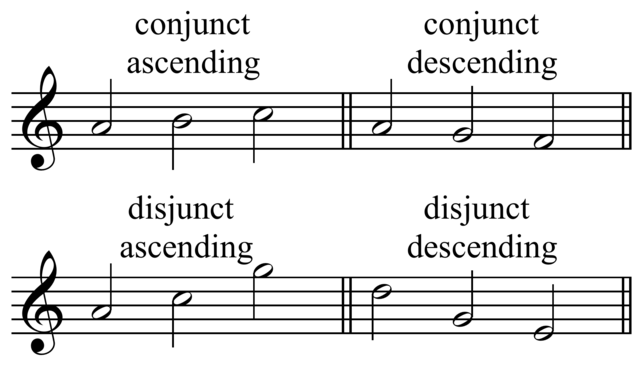Top Qs
Timeline
Chat
Perspective
Melodic motion
From Wikipedia, the free encyclopedia
Remove ads
Melodic motion is the quality of movement of a melody, including nearness or farness of successive pitches or notes in a melody. This may be described as conjunct or disjunct, stepwise, skipwise or no movement, respectively. See also contrapuntal motion. In a conjunct melodic motion, the melodic phrase moves in a stepwise fashion; that is the subsequent notes move up or down a semitone or tone, but no greater. In a disjunct melodic motion, the melodic phrase leaps upwards or downwards; this movement is greater than a whole tone. In popular Western music, a melodic leap of disjunct motion is often present in the chorus of a song, to distinguish it from the verses and captivate the audience.

Remove ads
In traditional culture music
Summarize
Perspective
Ethnomusicologist Bruno Nettl describes various types of melodic movement or contour to categorise a song's melody.
There are three general categories, ascending, descending, and undulating:[1]
- Ascending: Upwards melodic movement (only found in remote regions).
- Descending: Downwards melodic movement (prevalent in the New World and Australian music).
- Undulating: Equal movement in both directions, using approximately the same intervals for ascent and descent (prevalent in Old World culture music). Usually concludes with a descending progression.
- Pendulum: Extreme form of undulating movement that covers a large range and uses large intervals is called pendulum-type melodic movement. Like undulating melodies, usually concludes with a descending progression.
According to Nettl, undulating and descending melodies are far more common than ascending ones.[2]
He also identifies additional specialized types which characterise musical styles with exceptionally homogenous contours, named after the melody contour's trace.[3]
- Tile, terrace, or cascading: a number of descending phrases in which each phrase begins on a higher pitch than the last ended (prevalent in the North American Plain Indians music).
- Arc: The melody rises and falls in roughly equal amounts, the curve ascending gradually to a climax and then dropping off (prevalent among Navajo and North American Indian music)
In addition to this, rise, which may be considered a musical form, is a contrasting section of higher pitch, a "musical plateau".[4]
Other examples include:
- Double tonic: smaller pendular motion in one direction
These all may be modal frames or parts of modal frames.
Remove ads
See also
Citations
Bibliography
Further reading
Wikiwand - on
Seamless Wikipedia browsing. On steroids.
Remove ads
